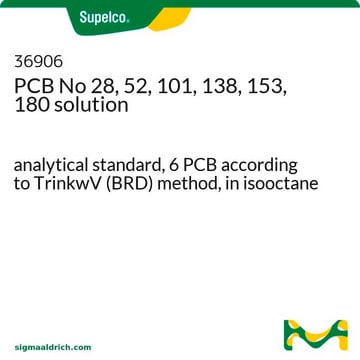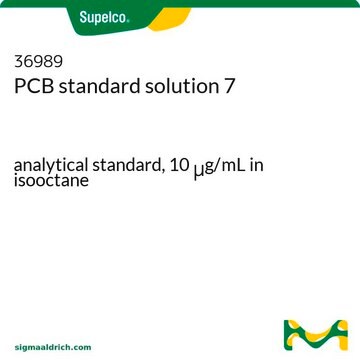35596
PCB No 3
analytical standard
Synonym(s):
4-Chlorobiphenyl, 4-PCB
Sign Into View Organizational & Contract Pricing
All Photos(1)
About This Item
Empirical Formula (Hill Notation):
C12H9Cl
CAS Number:
Molecular Weight:
188.65
Beilstein:
774966
Ballschmiter Number:
3
EC Number:
MDL number:
UNSPSC Code:
41116107
PubChem Substance ID:
NACRES:
NA.24
Recommended Products
grade
analytical standard
shelf life
limited shelf life, expiry date on the label
technique(s)
HPLC: suitable
gas chromatography (GC): suitable
application(s)
environmental
format
neat
SMILES string
Clc1ccc(cc1)-c2ccccc2
InChI
1S/C12H9Cl/c13-12-8-6-11(7-9-12)10-4-2-1-3-5-10/h1-9H
InChI key
FPWNLURCHDRMHC-UHFFFAOYSA-N
Looking for similar products? Visit Product Comparison Guide
General description
Polychlorinated biphenyls (PCBs) belong to the class of highly toxic pollutants commonly found in various environmental matrices and food products. They find a variety of applications as flame retardants, plasticizers, dielectric and heat transfer fluids, etc.
Application
PCB No 3 may be used as an analytical reference standard for the quantification of the analyte in aqueous solution in the presence of dissolved organic carbon using high-performance liquid chromatography technique.
Refer to the product′s Certificate of Analysis for more information on a suitable instrument technique. Contact Technical Service for further support.
Recommended products
Find a digital Reference Material for this product available on our online platform ChemisTwin® for NMR. You can use this digital equivalent on ChemisTwin® for your sample identity confirmation and compound quantification (with digital external standard). An NMR spectrum of this substance can be viewed and an online comparison against your sample can be performed with a few mouseclicks. Learn more here and start your free trial.
Signal Word
Warning
Hazard Statements
Precautionary Statements
Hazard Classifications
Aquatic Acute 1 - Aquatic Chronic 1 - STOT RE 2
Storage Class Code
11 - Combustible Solids
WGK
WGK 3
Flash Point(F)
Not applicable
Flash Point(C)
Not applicable
Personal Protective Equipment
dust mask type N95 (US), Eyeshields, Gloves
Choose from one of the most recent versions:
Already Own This Product?
Find documentation for the products that you have recently purchased in the Document Library.
Customers Also Viewed
Anna Ptak et al.
Toxicology letters, 164(2), 113-122 (2006-01-18)
The present study was undertaken to investigate the endocrine disrupting activity of PCB3 and its hydroxylated metabolites 4-OH-PCB3 and 3,4-diOH-PCB3 in ovarian follicle cells derived from prepubertal animals with special emphasis on cytochrome P-450-dependent aromatase (CYP19). Aromatase activity was assayed
Direct determination of hydrophobic organic compounds in aqueous solution in the presence of dissolved organic carbon by high-performance liquid chromatography
Schulze M, et al.
Chemosphere, 39(13), 2365-2374 (1999)
Donna L Bedard et al.
Environmental science & technology, 39(17), 6831-6838 (2005-09-30)
We have characterized the substrate range of Process LP, a PCB dechlorination activity mediated by anaerobic bacteria, in Housatonic River sediment (Lenox, MA). Process LP has the rare ability to remove unflanked para chlorines from polychlorinated biphenyls (PCBs). We used
Guangshu Zhai et al.
Environmental science & technology, 44(10), 3901-3907 (2010-04-21)
4-Monochlorobiphenyl (CB3), mainly an airborne pollutant, undergoes rapid biotransformation to produce hydroxylated metabolites (OH-CB3s). However, up to now, hydroxylation of CB3 has not been studied in living organisms. In order to explore the formation of hydroxylated metabolites of CB3 in
Markus Alexander Zettner et al.
Toxicological sciences : an official journal of the Society of Toxicology, 100(1), 88-98 (2007-08-10)
4-Monochlorobiphenyl (PCB3) is a component of commercial polychlorinated biphenyl (PCB) products and is an airborne environmental pollutant. Our recent study with transgenic Fischer 344 rats revealed the mutagenic potential of PCB3 in the livers of male rats. PCB3 is converted
Our team of scientists has experience in all areas of research including Life Science, Material Science, Chemical Synthesis, Chromatography, Analytical and many others.
Contact Technical Service











